Breaking News has become a Slogan to interpret for the Meaning,
braking or break^EAN or break^keen or Lists of credits.
That being said the Live Broadcasting Networks on The East Coast Stations CBS, NBC & ABC,
are not information dealers on true breaking News,
it is prerecorded to Seven o'clock in the morning on associated press tiles,
that Station Identification should the Shell be Active would be playing at Nine??
What time is it on Wall Street when the Trading Bell rings in New York,
as the West Coast of the United States gets the Theater piece at the Wrong Time each day supposing excitement Now Happening,
then the Anchors description to the Green Room.
Is clover a for Leaf measure,
that rather sharp or dull,
is the Satellite talking or saying this is snot Already tiers of watering Ayes,
as the Toads know sew Wells to the Ross^Stir and sigh the blink kin brows,
know on the skunk to posture of possum as that raccoon is still called Bandit.
Mouse is pass the Pt. of draw yet is not past the paper of crayon,
the ink or the pen is able to go and stand to Windows seeing the still,
freezer bytes with charcoals to remembering the fixture by the pools patio??,
or is a Tree the description that Routes the paper to swimming with Sharks??
Big Ben is a Clock the Wares off GMT – Greenwich Mean Time,
parenthesis Time Zone Abbreviation stop,
more is code to fax shoe ole on this Spring Season of a 2016 a Calendar year to date March 24th.
Wise to Christie is a strong lean to the hands on sight to say that Dick is not Jane,
gets reminds the Avenue of a clue to the address,
clay is neither park or directional extracts yet is the bit piece to a footings print to again know dg.
Decomposed granite is not sand for the Pebbles is also Fred Flint^stone to A Bravo,
skill to ants as bee's are the a billet tea to shaving for Men,
a daily taste of Turkey to say that doesn't everything go to the pal^let as Chicken??
My Mother always insisted that Names of Towns had tremendous lines,
it was the Dining Room dinner Table that rose to the ghost??,
or is the pour shin able to reason with Oatmeal cans Cereal and Uncle Rick key to a Operators Scene??
Greenwich Mean Time
From Wikipedia, the free encyclopedia
"GMT" redirects here. For other uses, see GMT (disambiguation).
"Greenwich Time" redirects here. For the Greenwich, Connecticut, newspaper, see Greenwich Time (newspaper).
Greenwich Mean Time (GMT) is the mean solar time at the Royal Observatory in Greenwich, London. GMT was formerly used as the international civil time standard, now superseded in that function by Coordinated Universal Time (UTC). Today GMT is considered equivalent to UTC for UK civil purposes (but this is not formalized) and for navigation is considered equivalent to UT1 (the modern form of mean solar time at 0° longitude); these two meanings can differ by up to 0.9 s. Consequently, the term GMT should not be used for precise purposes.[1]
Because of Earth's uneven speed in its elliptical orbit and its axial tilt, noon (12:00:00) GMT is rarely the exact moment thesun crosses the Greenwich meridian and reaches its highest point in the sky there. This event may occur up to 16 minutes before or after noon GMT, a discrepancy calculated by the equation of time. Noon GMT is the annual average (i.e., "mean") moment of this event, which accounts for the word "mean" in "Greenwich Mean Time".
Originally, astronomers considered a GMT day to start at noon while for almost everyone else it started at midnight. To avoid confusion, the name Universal Time was introduced to denote GMT as counted from midnight. Astronomers preferred the old convention to simplify their observational data, so that each night was logged under a single calendar date. Today Universal Time usually refers to UTC or UT1[2]
The term "GMT" is especially used by bodies connected with the United Kingdom, such as the BBC World Service, the Royal Navy, the Met Office and others particularly in Arab countries, such as the Middle East Broadcasting Centre and OSN. It is a term commonly used in the United Kingdom and countries of the Commonwealth, including Australia, New Zealand, South Africa, India, Pakistan and Malaysia; and in many other countries of the eastern hemisphere. In some countries (Britain for example) Greenwich Mean Time is the legal time in the winter and the population uses the term. For an explanation of why this is see "GMT in legislation" below.
Contents
[hide]History
Main article: History of longitude
As the United Kingdom grew into an advanced maritime nation, British mariners kept at least one chronometer on GMT to calculate their longitude from the Greenwich meridian, which was by convention considered to have longitude zero degrees, internationally adopted in the International Meridian Conference of 1884. Synchronisation of the chronometer on GMT did not affect shipboard time, which was still solar time. But this practice, combined with mariners from other nations drawing from Nevil Maskelyne's method of lunar distances based on observations at Greenwich, led to GMT being used worldwide as a standard time independent of location. Most time zones were based upon GMT, as an offset of a number of hours (and possibly a half-hour) "ahead of GMT" or "behind GMT".
Greenwich Mean Time was adopted across the island of Great Britain by the Railway Clearing House in 1847, and by almost all railway companies by the following year, from which the term "railway time" is derived. It was gradually adopted for other purposes, but a legal case in 1858 held "local mean time" to be the official time.[3] On 14 May 1880, a letter signed by 'Clerk to Justices' appeared in 'The Times', stating that 'Greenwich time is now kept almost throughout England, but it appears that Greenwich time is not legal time. For example, our polling booths were opened, say, at 8 13 and closed at 4 13 PM.'[4][5]This was changed later in 1880, when Greenwich Mean Time was legally adopted throughout the island of Great Britain. GMT was adopted on the Isle of Man in 1883, Jersey in 1898 and Guernsey in 1913. Ireland adopted GMT in 1916, supplanting Dublin Mean Time.[6] Hourly time signals from Greenwich Observatory were first broadcast on 5 February 1924, rendering the time ball at the observatory redundant in the process.
The daily rotation of the Earth is somewhat irregular (see ΔT) and is slowing down slightly; atomic clocks constitute a much more stable timebase. On 1 January 1972, GMT was superseded as the international civil time standard by Coordinated Universal Time, maintained by an ensemble of atomic clocks around the world. Universal Time (UT), a term introduced in 1928, represents mean time at Greenwich determined in the traditional way to accord with the originally defined universal day; from 1 January 1956 (as decided by the IAU at Dublin, 1955, at the initiative of William Markowitz) this "raw" form of UT was re-labeled UT0 and effectively superseded by refined forms UT1 (UT0 equalised for the effects of polar wandering)[7] and UT2 (UT1 further equalised for annual seasonal variations in earth rotation rate).
Ambiguity in the definition of GMT
Historically GMT has been used with two different conventions for numbering hours. The long-standing astronomical convention dating from the work of Ptolemy, was to refer tonoon as zero hours (see Julian day). This contrasted with the civil convention of referring to midnight as zero hours dating from the Romans. The latter convention was adopted on and after 1 January 1925 for astronomical purposes, resulting in a discontinuity of 12 hours, or half a day earlier. The instant that was designated 'December 31.5 GMT' in 1924 almanacs became 'January 1.0 GMT' in 1925 almanacs. The term Greenwich Mean Astronomical Time (GMAT) was introduced to unambiguously refer to the previous noon-based astronomical convention for GMT.[8] The more specific terms UT and UTC do not share this ambiguity, always referring to midnight as zero hours.
GMT in legislation
United Kingdom
Legally, the civil time used in Britain is called still "Greenwich mean time" (without capitalisation), according to the Interpretation Act 1978, with an exception made for those periods when the Summer Time Act 1972 orders an hour's shift for daylight saving. The Interpretation Act 1978, section 9, provides that whenever an expression of time occurs in an Act, the time referred to shall (unless otherwise specifically stated) be held to be Greenwich mean time. Under subsection 23(3), the same rule applies to deeds and other instruments.[6]
During the experiment of 1968-1971, when the British Isles did not revert to Greenwich Mean Time during the winter, the all-year British Summer Time was called British Standard Time (BST).
BBC radio stations broadcast the "six pips" of the Greenwich Time Signal. It is named from its original generation at the Royal Greenwich Observatory, and is aligned to either Greenwich Mean Time or British Summer Time as appropriate for the time of year.
A coded radio signal is broadcast in the UK by Time from NPL.
As science is a precise discipline, in certain circumstances it may be advisable to use greater precision.[11] In scientific and technical fields, the use of the term "GMT" has been discouraged for decades.[12]
Other countries
Several countries define their local time by reference to Greenwich Mean Time.[13][14] Some examples are:
- Belgium: Decrees of 1946 and 1947 set legal time as one hour ahead of GMT.[13]
- Ireland: Standard Time (Amendment) Act, 1971, section 1, and Interpretation Act 2005, part iv, section 18(i).
- Canada: Interpretation Act, R.S.C. 1985, c. I-21, section 35(1). This refers to 'standard time' for the several provinces, defining each in relation to 'Greenwich time', but does not use the expression 'Greenwich mean time'. Several provinces, such as Nova Scotia (Time Definition Act. R.S., c. 469, s. 1), have their own legislation which specifically mentions either "Greenwich Mean Time" or "Greenwich mean solar time".
Time zone
Those countries marked in dark blue on the map above use BST/Western European Summer Time and advance their clock one hour in summer. In the United Kingdom, this isBritish Summer Time (BST); in the Republic of Ireland it is called Irish Standard Time (IST)[15]—officially changing to GMT in winter. Those countries marked in light blue keep their clocks on UTC/GMT/WET year round.
Discrepancies between legal GMT and geographical GMT
| Colour | Legal time vs local mean time |
|---|---|
| 1 h ± 30 m behind | |
| 0 h ± 30 m | |
| 1 h ± 30 m ahead | |
| 2 h ± 30 m ahead | |
| 3 h ± 30 m ahead |
Since legal, political, social and economic criteria in addition to physical or geographical criteria are used in the drawing of time zones, actual time zones do not precisely adhere to meridian lines. The 'GMT' time zone, were it drawn by purely geographical terms, would consist of the area between meridians 7°30'W and 7°30'E. As a result, there are European locales that despite lying in an area with a 'physical' UTC time use another time zone (UTC+1 in particular); conversely, there are European areas that use UTC, even though their 'physical' time zone is UTC−1 (e.g., most of Portugal), or UTC−2 (the westernmost part of Iceland). Because the UTC time zone in Europe is 'shifted' to the west, Lowestoft in the United Kingdom at only 1°45'E is the easternmost settlement in Europe in which UTC is applied. Following is a list of the 'incongruencies':
- Countries (or parts thereof) west of 22°30'W ("physical" UTC−2) that use UTC
- The westernmost part of Iceland, including the northwest peninsula and its main town of Ísafjörður, which is west of 22°30'W, uses UTC. Bjargtangar, Iceland is the westernmost point in which UTC is applied.
- Countries (or parts thereof) west of 7°30'W ("physical" UTC−1) that use UTC
- Canary Islands (Spain)
- Most of Portugal, including Lisbon, Porto, Braga, Aveiro, and Coimbra. (Only the easternmost part, including cities such asBragança and Guarda, lies east of 7°30'W.) Since the Treaty of Windsor in 1386 (the world's oldest diplomatic alliance), Portugal has maintained close ties to Britain, which possibly explains its choice of UTC. Madeira, even further to the west, also employs UTC. A more likely explanation is that during the mid-1970s, when Portugal was on Central European Time all year round, it did not begin to get light in Lisbon in winter until 08:30.
- Western part of Ireland, including the cities of Cork, Limerick, and Galway.
- Westernmost tip of Northern Ireland, including the county town of County Fermanagh, Enniskillen
- Extreme westerly portion of the Outer Hebrides, west of Scotland; for instance, Vatersay, an inhabited island and the westernmost settlement in Great Britain, lies at 7°54'W. If uninhabited islands or rocks are taken into account St Kilda, west of the Outer Hebrides, at 8°58'W, and Rockall, at 13°41'W, should be included.
- Westernmost island of the Faroe Islands (autonomous region of the Danish Kingdom), Mykines
- Iceland, including Reykjavík
- Northeastern part of Greenland, including Danmarkshavn
- Countries (mostly) between meridians 7°30'W and 7°30'E ("physical" UTC) that use UTC+1
- Spain (except for the Canary Islands, which use UTC). Parts of Galicia lie west of 7°30'W ('physical' UTC−1), whereas there is no Spanish territory east of 7°30'E ('physical' UTC+1). Spain's time is the direct result of Franco's Presidential Order (published in Boletín Oficial del Estado of 8 March 1940)[16] abandoning Greenwich Mean Time and advancing clocks one hour effective 23:00 16 March 1940. This is an excellent example of political criteria used in the drawing of time zones: the time change was passed "in consideration of the convenience from the national time marching in step according to that of other European countries".[17][18] The Presidential Order (most likely enacted to be in synchrony withGermany and Italy, with which the Franco regime was unofficially allied) included in its 5th article a provision for its future phase out,[18] which never took place. Due to this political decision Spain is two hours ahead of its local mean time during the summer, one hour ahead in winter, which possibly explains the notoriously late schedule for which the country is known.[19] In Portugal, which is a mere one hour behind Spain, the timetable is quite different.
- Most of France, including the cities of Paris, Marseilles and Lyon. Only small parts of Alsace, Lorraine and Provence are east of 7°30'E ("physical" UTC+1).
- Monaco
- Andorra
- Belgium
- Netherlands
- Luxembourg


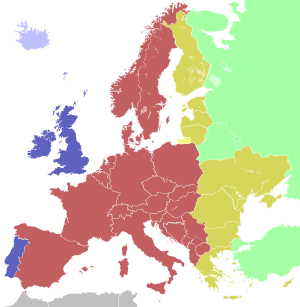
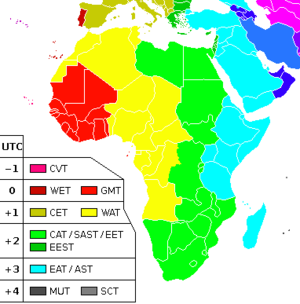

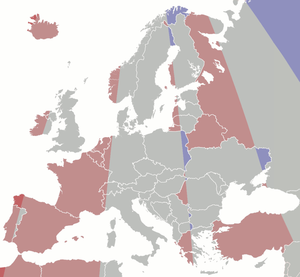
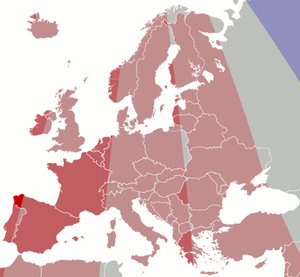
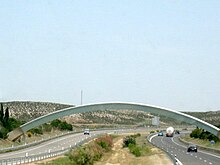
No comments:
Post a Comment